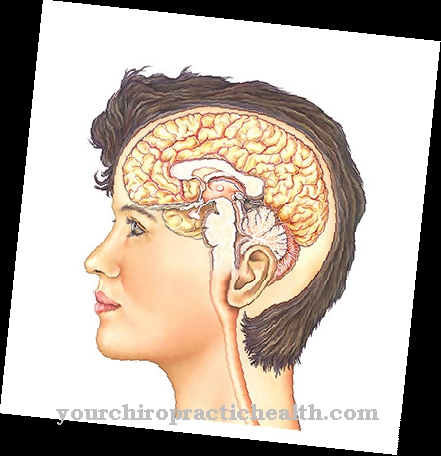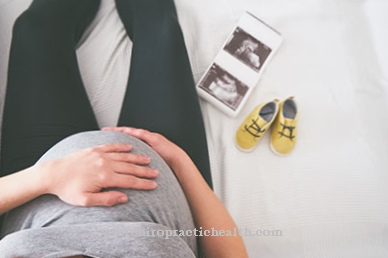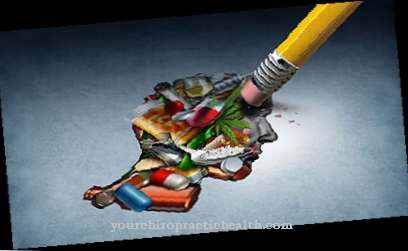The Herpangina is an infectious disease that predominantly affects babies and children under 7 years of age. Healing with few complications usually takes place independently.
What is herpangina?

© Aisylu - stock.adobe.com
Herpangina in babies and children is a viral infectious disease in which the palate and throat are locally infected. Herpangina is also used by doctors in Baby & Child as Zahorsky's disease designated.
Herpangina occurs more frequently during the summer and autumn months. Especially in public facilities such as day nurseries or kindergartens, there is usually an increased risk that herpangina will spread to babies and children during these times.
Outwardly visible signs of a possible herpangina are vesicular inflammation of the mucous membranes. Further symptoms that can occur in connection with herpangina in babies and children are, for example, headache, fever of up to 40 ° C and sore throat, which are accompanied by difficulty swallowing.
causes
The cause of herpangina, which can occur in babies and children, is an infection with the so-called Coxackie viruses. Herpangina can be transmitted in babies and children via a droplet or smear infection.
This means that viruses from babies and children infected with Herpangina can initially be transmitted to other children via secretions from the throat and nose. Since the viruses that are responsible for herpangina are excreted with the stool of infected children, herpangina can also occur in babies and children through contact with excretions.
There is a risk of infection from other children who have herpangina until the disease has healed.
Symptoms, ailments & signs
In herpangina, the mucous membranes of the mouth and throat swell after an incubation period of around two to six days. The affected area is very red. Two to three millimeters large, dark red-edged blisters form. These soon develop into flat, painful, and inflamed ulcers that are particularly sensitive to acids.
Usually only the palatal arch is affected. In rare cases, vesicles form on the tonsils, the lining of the cheek, the gums and the tongue. The lips and the floor of the mouth are not affected. Overall, the maximum number of 20 bubbles is not exceeded. The throat is painful and usually feels furry. The affected children often have difficulty swallowing. This can also lead to food refusal.
Furthermore, symptoms such as loss of appetite, vomiting, nausea and abdominal pain occur. Often there is also a general feeling of illness, headaches and fatigue. A rapid rise in fever of up to 40 ° C is typical of herpangina. However, the fever subsides after just one day. In rare cases, it lasts for a few days. Usually the herpangina heals on its own within seven days. The mouth and throat areas affected by the blisters recover completely within two weeks.
Diagnosis & course
Herpangina disease can often be suspected in babies and children based on the symptoms that typically occur. In addition to the symptoms mentioned, such as inflammatory blisters, headaches and difficulty swallowing, herpangina can manifest itself in babies and children as a general feeling of illness, abdominal pain, nausea and / or loss of appetite.
To confirm the diagnosis of Herpangina, the virus that caused it can also be found in the throat or stool of an infected baby or child; however, this is usually not necessary.
The course of a herpangina in babies and children is usually free of complications; the disease heals on its own after two weeks at the latest; usually the herpangina only extends over a few days. Occasionally, the blisters that appear in herpangina can develop into ulcers, which can be painful.
Complications
Herpangina in babies and children does not usually lead to any particular complications or complaints. In most cases the disease heals on its own, so no medical treatment is necessary. This primarily results in severe swelling of the mucous membrane in the throat and mouth. This also leads to difficulty swallowing, which can lead to a refusal to eat.
The patient's intake of fluids is also generally restricted, which can lead to deficiency symptoms and dehydration. Especially in children, the physical and mental development of the child is greatly slowed down by these complaints. Furthermore, fever occurs and the person concerned usually suffers from tiredness and fatigue.
It is not uncommon for headaches to occur, which can lead to irritation, especially in children. Special treatment of herpangina in babies and children is not necessary. The symptoms can be alleviated with the help of pain killers or throat tablets. Furthermore, the child must rest. After a few days the symptoms will go away on their own.
When should you go to the doctor?
A doctor's visit is necessary if the child shows very abnormal behavior. Weepiness, apathy, indifference or a particularly aggressive demeanor should be examined.
If there is reddening or blistering on the mucous membranes in the mouth or on the gums, a doctor should clarify the abnormalities. If the teeth cleaning is refused or the child complains of pain, this should be checked. Consult a doctor if you experience symptoms such as vomiting, nausea, or increased body temperature.
A medical examination is required as soon as the symptoms persist for several days and increase in intensity. If the baby or child refuses to feed, there is cause for concern. A doctor should be consulted as soon as weight loss occurs or no fluids have been ingested for a long period of time. With internal dryness, the risk of dehydration increases and thus the risk of a life-threatening condition increases.
A doctor is needed if the headache, stomach ache or sore throat persists. If swallowing problems occur, if the child is hoarse or no longer speaks, a doctor is needed. A doctor should be consulted in the event of insomnia, decreased concentration or problems of alertness. If participation in social life falls and the child shows a general weakness, a doctor's visit is necessary.
Doctors & therapists in your area
Treatment & Therapy
In many cases, medical treatment for herpangina is not necessary. However, severe symptoms that occur in connection with herpangina in babies and children can be alleviated with the help of various measures: High fever in herpangina can be reduced, for example, by giving fever-reducing medicines.
In the case of severe sore throats that can occur during herpangina, lozenges can help alleviate the symptoms. Mouth rinses, for example, can be used against inflammatory processes of the oral mucosa in connection with herpangina, which help the inflammation subside.
Measures that can support the healing of herpangina in babies and children at home are, for example, protection of the infected baby or child and extensive bed rest. In order to ensure a sufficient supply of liquid and food even with severe swallowing difficulties, which can occur in the context of herpangina, the administration of soft food and liquids is often recommended that do not cause the mucous membranes to sting (as is the case with fruit juices or . Fruit can happen).
Outlook & forecast
The prognosis of herpangina in babies and children is usually favorable. The disease usually heals within a few days or weeks without any further complications or secondary diseases.
Often no medical care is given to the infant or child because it is not needed. This is especially true in patients who show only a few symptoms and the progression of the disease stagnates within a few hours or days. Depending on the severity of the disease, painful symptoms or skin changes can still occur in the patient.
Since they have a negative impact on the child's general well-being, parents and doctors often decide on a need for action. The symptoms that have occurred are treated with drug treatment. After a short time, the symptoms will ease and the disease will gradually heal.
Delays in the healing process can occur in patients who are simultaneously suffering from other diseases. Since the child's immune system is not yet fully developed, excessive demands occur which contribute to a slow recovery. Nevertheless, the prognosis for herpangina does not change overall. It remains cheap.
In addition to drug treatment, the healing process can also be promoted through the selection of food intake. This improves the general well-being and strengthens the child's immune system.
prevention
Herpangina in babies and children can be prevented by avoiding direct physical contact with infected babies or children. Hygiene measures can also help to reduce the risk of smear infection of the herpangina.
Aftercare
In most cases of herpangina in babies and children, no special aftercare is necessary. Usually this is not possible either. It is a mild infectious disease that can heal on its own, so that a visit to a doctor is not always necessary. However, the parents of the affected child should recognize the symptoms and signs of the disease at an early stage and consult a doctor if the disease worsens.
The life expectancy of the child is in most cases not reduced by this disease. Treatment is usually accomplished by taking medication. The parents should continuously monitor the child's body temperature and administer antipyretic agents if the fever is high.
If anything is unclear or if you have any questions, it is advisable to consult a doctor first so that there are no interactions or undesirable side effects. In general, patients with herpangina in babies and children are dependent on strict bed rest. There should be no strenuous or physical activity. A sufficient supply of fluids should also be ensured so that there are no discomforts in the mouth.
You can do that yourself
In the case of herpangina, parents can support their children in many ways. Since the administration of antibiotics is not indicated in the case of a viral infection, only the symptoms are treated.
The child's organism has to fight the virus itself. Sufficient fluid intake is important in the event of a high fever. What the child likes is allowed. Ideally, still mineral waters or unsweetened herbal tea are drunk. Temperatures above 40 degrees Celsius can be reduced by using leg wraps or cooling the whole body in the bathtub. However, a stable cycle is absolutely essential.
Mouthwashes are effective for treating the blisters in the mouth and throat: these can be purchased ready-made at the pharmacy or easy to make yourself. Sage or chamomile infusions are recommended. They have a germicidal and astringent effect. Sugar-free lozenges made from sage or rockrose can already be given to older children.
Irritant foods and drinks such as fruit juices and coarse, spicy foods should be avoided. A strengthening chicken broth with noodles, on the other hand, is beneficial and easy to consume. Physical rest is also important so that the organism can concentrate on the healing process.
Homeopathy recommends the remedies Acidum muriaticum 30C for skin rashes and Rhus toxicodendron 9C, which is especially indicated for itching. Mercurius corrosivus supports the healing of inflammatory processes in the mucous membranes.
























.jpg)


